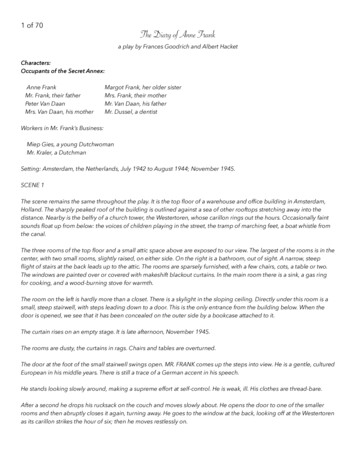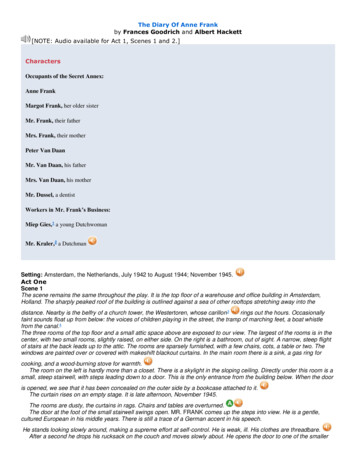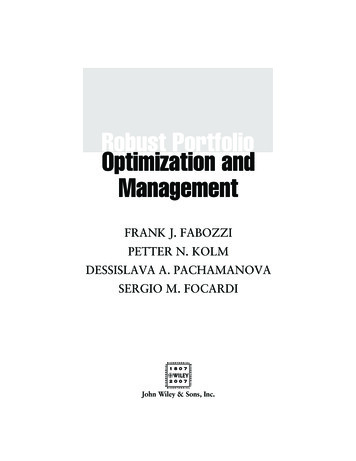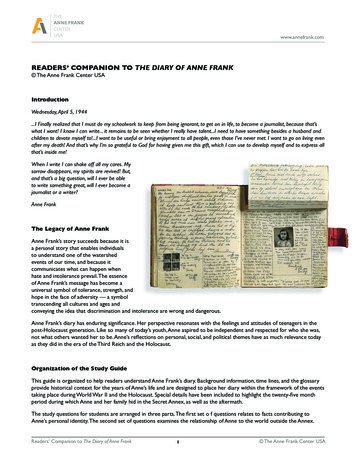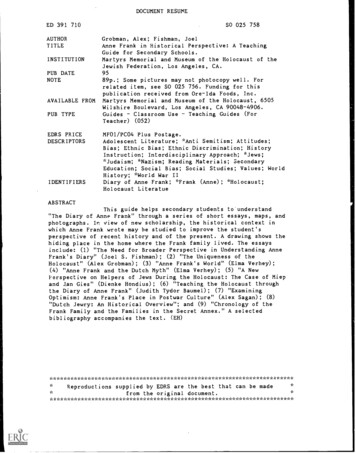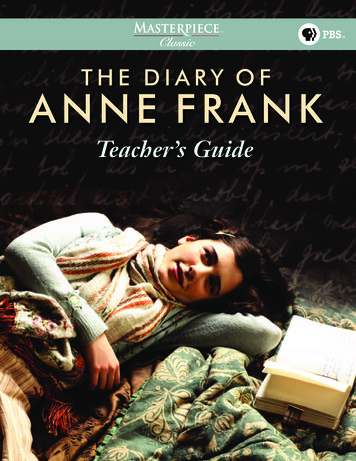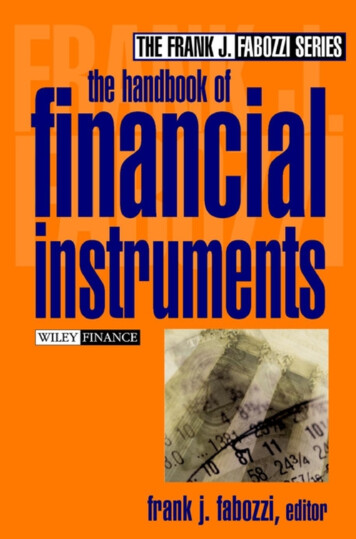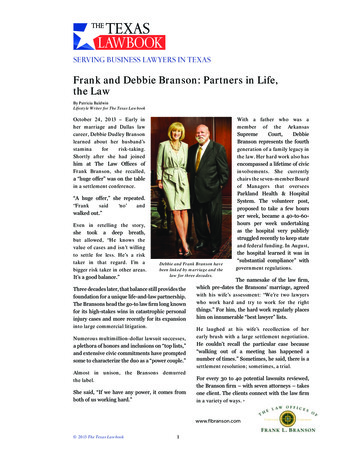
Transcription
Frank H. Wu, "The Model Minority: Asian American 'Success' as a Race RelationsFailure," from Yellow: Race in America Beyond Black and White (New York: BasicBooks, 2002): 39-77
2The Model MinorityAsian American "Success" asa Race Relations FailureStudent: "Asians are threatening our economic future . . . We can see it right here in our own school. Who aregetting into the best colleges. in disproportionate numbers?Asian kids! It's not fair."Teacher: "Uh . That certainly was an unusual essay. Unfortunately, it's racist."Student: "Urn . are you sure? My parents helped me,"-GARRY TRUDEAURecycled Doonesbury: Second TIfOughts on a Gilded AgeRevenge of the NerdsI am not the model minority. Before I can talk about Asian American experiences at all, I have to kill off the model minority myth because the stereotype obscures many realities. I am an Asian American, but I am not good withcomputers. I cannot balance my checkbook, much less perform calculus inmy head. I would like to fail in school, for no reason other than to cast offmy freakish alter ego of geek and nerd. I am tempted to be very rude, just to39
YELLOW44breakthroughs in biology and chemistry, and publishing papers that make thefaculty envious as they strive toward a Nobel prize. If they engage in frivolous activities after hours, as they rarely do, they are betrayed by their telltalered faces, which they develop after drinking just half a glass of beer.Eventually, they land a job at a high-tech company Of they start their own.Making millions, they buy big houses in the suburbs or build monstrositiesright up to the property line on vacant lots. They bring their relatives over,starting the cycle over again.In the view of other Americans, Asian Americans vindicate the AmericanDream. A publicity campaign designed to secure the acceptance of AsianAmericans could hardly improve perceptions. They have done better herethan they ever could have dreamed of doing in their homelands. They are living proof of the power of the free market and the absence of racial discrimination. Their good fortune flows from individual self-reliance and communityself-sufficiency, not civil rights activism or government welfare benefits. Theybelieve that merit and effort payoff handsomely and justly, and so they do.Asian Americans do not whine about racial discrimination; they only tryharder. If they are told that they have a weakness that prevents their socialacceptance, they quickly agree and earnestly attempt to cure it. If they are subjected to mistreatment by their employer, they quit and found their owncompany rather than protesting or suing.This caricature is the portrait of the model minority. It is a parody of itself.In The Abilities and Achievements of Orientals in North America, 11 Universityof Calgary psychologist Philip E. Vernon perfectly captures the prevailingopinions about Asian Americans. Vernon describes Chinese and Japaneseimmigrants to the United States and Canada:The experiences of oriental immigrants in the United States and CanadaChinese andJapanese--provide a remarkable example of adverse environmentnot affecting the development of intelligence. There is no doubt that, in thepast, they were subjected to great hardships, hostility, and discrimination. They\'1lere regarded as a kind of inferior species, who could be used for unskilledlabor and menial jobs, but could never be accepted as equals into the whitecommunity. And yet Orientals survived and eventually flourished until theycame to be regarded as even higher achievers, educationally and vocationally,than the white majority. I"Vernon's research is typical of the tradition of the model minority myth. Hecontrasts past discrimination against Asian Americans with the present suc-
The Model Minority45cess of Asian Americans. He reviews copious quantities of seemingly objective data from the United States and elsewhere. He emphasizes intelligencetests suggesting that Asians outperform Caucasians both in the United Statesand overseas. He falls back on stereotypes about Asian behavior. Vernonexplains, "Chinese people still appear to whites as being exaggeratedly humble and deferential, and as oblique or devious in their business and othercommunications and interactions." He notes that "because they have different ways of expressing emotions from whites, they still seem to us inscrutableand reserved."!9Avoiding the debate over whether nature or nurture is more important tohuman development by assuming that race and culture more or less correlate, Vernon writes that "any genetically different groups always differ too intheir cultures."2o In later work, Vernon published findings that Asians havelarger heads than Caucasians and Africans and suggested that larger head sizecorrelates to higher intelligence. 21 Whatever the root causes for individualachievement, Vernon links the status of Asian Americans to their identity asAsian Americans. By his account, Asian Americans flourish because they areAsian Americans, and they continue to thrive only to the extent that theybehave as archetypal Asian Americans. Vernon summarizes the major factorin their "educational and occupational success" as "family upbringing" thatstresses seven elements:1. Adherence to accepted conventions of social behavior.2. Cohesion not only within a family but also with kin and the familyancestors.3. Discouragement of egocentricity and recognition of obligations toothers.4. Loyalty and obedience to the authorities, employers, and the state.5. Motivation for educational achievement from fmt entering schooluntil maturity.6. Firm control, not permissiveness, from about three years up.7. The need for hard work to gain success and honor the family.!?ByVernon's reckoning, these seven elements are distinctly Asian. "In spiteof the important differences between Japanese and Chinese cultures . childupbringing is similar . in most respects. and both differ greatly fromWestern models," he writes. "There are also resemblances to the Puritanwork ethic . but Orientals would probably not accept the Calvinistic viewthat man is responsible for the effects of his own actions, or that he is funda-
42YELLOWadoptive land, they hold,the potential not only to add to Republican rolls butto define a bon'a-fide American language of civil rights."16According to the model minority myth, Asian immigrants have followedthe beacon of economic opportunity from their homes in China, Japan,Korea, the Philippines, India, Vietnam, and all the other countries on theAsian continent and within the Pacific Rim. They might be fleeing despotism or Communism, backwardness or the deprivations or war and famine,but whatever the conditions of their past they know that the legend of Golden Mountain, to use the Cantonese phrase, guides their future.They arrive in America virtually penniless. They bring barely more thanthe clothes on their backs. Their meager physical possessions are less important than their mental capacity and work ethic. Thanks to their selflessdedication to a small business or an advanced degree in electrical engineering-or both-they are soon achieving the American Dream.They run a corner grocery in Manhattan, offering the freshest fruits andvegetables and serving up a take-out luncheon buffet priced by the pound.They buy a dry cleaning establishment in Los Angeles, featuring one-hourturnaround times and giving discounts to police officers. They start a motelfranchise, which spreads throughout the Midwest, boasting such low rateswith amenities like free cable television that other proprietors have no choicebut to post signs identifying their accommodations inaccurately as "NativeAmerican Owned."They begin a computer chip manufacturing plant in theSilicon Valley, inventing the hottest miniaturized gadgets before selling theirshareholdings and retiring at thirty-five. Or they open a boutique in Washington, D.c., with a display case of real-hair wigs on the wall above a bevyof manicurists chatting among themselves in another language while painting their customers' nails.They were doctors, nurses, engineers, scientists, professors, and librarians,but they have problems pursuing their professions because the requisitelicense is denied to them owing to their foreign education, or they are discriminated against because they have a heavy accent. Even if they are reducedto the drudgery of jobs for which they are overqualified, they are earningwhat they could never have in conditions of a developing country. Althoughthey may be sweating as a janitor despite holding a doctorate, the toil is on1ytemporary, until they can secure the patent for their discovery. In the interim, they can save enough to send remittances home to kinfolk who wantvery much to come here, too.Whatever endeavor they pursue, Asian Americans are astonishing for theirgung-ho enthusiasm. They remain busy with the chores called for by their
The Model Minority43enterprise twenty-four hours a day, seven days a week, through the holidays.After they sweep out their storefront entryway, they wash down the publicsidewalk.They come to dominate their trades after less than a decade, reducingtheir competition to the verge of bankruptcy and then buying up theirwarehouse stocks. Their associations become monopolies, lending moneycooperatively among their own members to preserve their collective advantage. In some cities, they hold more than half the commercial Iicenses andoperate a majority ofthe downtown "mom and pop" retail outlets. Hospitals and universities have departments wholly staffed by Asian immigrants.Private industries ranging from automobile manufacturers to softwaredevelopers to government agencies, such as the Defense Department,depend on them for research and development.In turn, their American-born progeny continue the tradition with theirstaggering academic prowess. They start ofT speaking pidgin, some of themeven being held back a grade to adjust. They are willing to do as they aretold, changing their given names to Anglicized Christian names chosen withthe help of their teachers and their friends and told matter of factly to theirparents. Above all, they study, study, study.They are brought up under the strict tutelage of parents who have sacrificed everything in the hopes that their children will garner more than whatthey themselves have lost. The parents defer everything for themselves andinvest it in their young, giving them the mission of redeeming the family.They maintain that anything less than a straight-A report card will shame theancestors, and they beat their children for receiving a single B-plus. The elders have faith in the school system. They instill respect for educators. Theytake their children to weekend language lessons instead of allowing them towatch Saturday morning cartoons on television.The no-nonsense regimen works wonders. A parade of prodigies namedChang, Nguyen, and Patel takes the prizes at piano recitals and proceeds tograduate from high school with honors as valedictorian, salutatorian, and therest of the top ten of the class, receiving full scholarships to the Ivy Leaguecolleges en route to graduate school and advanced professional training.In any course on campus, Asian Americans are the best (or worst) classmates. In a physics class, they wreck the grade curve, idly twirling their pensback and forth with thumb and forefinger during lectures, solving problemsets late into the night with their peers, breaking for fried rice seasoned withpungent fish sauce and accompanied by smelly kim chee. In the laboratory,they are polishing up projects begun when they were adolescents, making
YELLOWdemonstrate, once and for all that I will not be excessively polite, bowing,smiling, and deferring. I am lazy and a loner, who would rather reform thelaw than obey it and who has no business skills. I yearn to be an artist, an athlete, a rebel, and, above all, an ordinary person.I am fascinated by the imperviousness of the model minority myth againstall efforts at debunking it. I am often told by nice people who are bewilderedby the fuss, "You Asians are all doing well. What could you have to complainabout anyway? Why would you object to a positive image?" To my frustration, many people who say with the utmost conviction that they would liketo be color blind revert to being color conscious as soon as they look at AsianAmericans, but then shrug off the contradiction. They are nonchalant aboutthe racial generalization, "YoLl Asians are all doing well," dismissive in asking"What could you have to complain about anyway?," and indifferent to thenegative consequences of "a positive image."Even people who are sympathetic to civil rights in general, includingother people of color, sometimes resist mentioning civil rights and AsianAmericans together in the same sentence. It is as if Asian American civilrights concerns can be ruled out categorically without the need for seriousconsideration of the facts, because everyone knows that Asian Americans areprospering.Consider the term "overachiever." I am reluctant to accept the title formyself, and not out of Asian modesty. To be called an "overachiever" begs thequestion: What, exactly, is it that individuals have achieved over-what others expected of them or what they deserve?In either case, overachievers have surprised observers by surpassing thebenchmark, and their exploits are not quite right. They will get their comeuppance sooner or later. Applied to an entire racial group, as "overachiever"is to Asian Americans, the implications are troubling. Asian Americans, oftenthought of as intellectuals, will be consigned to the same fate as intellectuals.As Columbia University historian Richard Hofstadter stated in the openingpages of his Anti-Intellectualism in American. Life, "The resentment from whichthe intellectml has suffered in our time is a manifestation not of a decline inhis position but of his increasing prominence."lAnd so it is with Asian Americans. "You Asians are all doing well anyway"summarizes the model minority myth. This is the dominant image of Asiansin the United States. Ever since immigration reforms in 1965 led to a greatinflux of Asian peoples, we have enjoyed an excellent reputation. As a group,we are said to be intelligent, gifted in math and science, polite, hard working, family oriented, law abiding, and successfully entrepreneurial. We revere
TIle Model Minority4'our elders and show fidelity to tradition. The nation has become familiarwith the turn-of-the-century Horatio Alger tales of "pulling yourself up byyour own bootstraps" updated for the new millennium with an "Oriental"face and imbued with Asian values.This miracle is the standard depiction of Asian Americans in fact and fiction, from the news media to scholarly books to Hollywood movies. Fromthe 1960s to the 19905, profiles of whiz kid Asian Americans became . o common as to be cliches. In 1971, Newsweek magazine observed that we were"outwhiting the whites."2 People magazine one year made celebrities of thefive Asian American teenagers who swept the highest prizes in the annualWestinghouse science talent search in an article headlined "Brain DrainBoon for the U.S.," and it followed up the next year by profiling an entirefamily of Asian American winners.3 Brown University history professorStephen Graubard wrote an op-ed for The New York Times asking "Why DoAsian Pupils Win Those Prizes?"4 The Asian refugee who was a finalist in aspelling bee, but who lost on the word "enchilada," has become legendary.'Time, Newsweek, Sixty Minutes, and other media outlets have awarded AsianAmericans the title "model minority."(' Fortune magazine dubbed us the"superminority."7 The New Republic heralded, "the triumph of Asian Americans" as "America's greatest success story" and Commentary magazine referredto Asian Americans as "a trophy population." The New York Times announcedthat we are "going to the head of the class."ry The Hltlshington Post said in aheadline, "Asian Americans Outperform Others at School and Work."wSmith College sociologist Peter Rose has described Asian Americans as making a transition "from pariahs to paragons."" Memoirist Richard Rodriguezand Washington Post columnist William Raspberry have wondered whetherHispanics and blacks, respectively, might be able to emulate Asian immigrants. n A minority group could become the equivalent of a white real estatedeveloper: Advertisif1g Age quoted a consultant who opined that Asian Americans were "the Donald Trumps of the 1990s."'·1Conservative politicians especially like to celebrate Asian Americans. President Ronald Reagan called Asian Americans "our exemplars of hope."'4President George Bush, California Governor Pete Wilson, House SpeakerNewt Gingrich-all have been unduly awed by the model minority myth.In a brief for the Heritage Foundation Policy Review, California politician RonUnz said that Asian Americans come from an "anti-liberal Confucian tradition" that "leaves them a natural constituency for conservatives."'"' In theNational Review, author William McGurn made the model minority myth apartisan parable: "Precisely because Asian Americans are making it in their
YELLOWmentally evil, but can overcome this and achieve both grace and economicsuccess," he adds. To make the point as adamantly as possible, he warns,"When the tradition has yielded to modern American fashions, it doesappear that educational achievement is lowered, and that there is more delinquency, though still much below the white norm."1JWith his twenty-three-page bibliography of sources spanning the twentieth century and the globe, covering the whole history of intelligence testing,Vernon looks reputable. He cannot be dismissed as a crackpot, and his workbecomes troubling only upon a thorough reading. He was funded by the Pioneer Fund, which has promoted eugenics and racial separatism. 24 He workedwith the notorious Arthur Jensen, the University of California at Berkeleyphysicist who claims that African Americans are genetically inferior.However, if the message were true it would remain true regardless of themessenger, and ad IWlnil1e111 attacks would be inappropriate. Likewise, if theassertions are incorrect they remain incorrect even if espoused by other messengers, lacking the same ideological connections. Indeed, many researchersshare Vernon's convictions about Asian American behavior as well as its causes. Furthermore, they have impeccable credentials and cannot be impugnedas biased. Their work, however, should not be regarded as persuasive merelybecause it lacks an overt racial agenda. It may be imperfect because of itsracial assumptions. The flaw is embedded as an integral part of the researchmethodology and the worIdview it represents.Julian C. Stanley, a researcher at Johns Hopkins specializing in the academically gifted, has written a single-page article posing the title question,"Do Asian Americans Tend to Reason Better Mathematically Than WhiteAmericans?" His answer is emphatic in the opening line: "The answer . isa resounding 'yes,' or even 'of course."'" Stanley operates a center for mathematically precocious youth, which carries out annual nationwide searchesfor subjects who at the age of thirteen score 700 or higher on the math portion of the SAT. For decades, he has been finding children who, before theyhave entered high school, have abilities equal to the top 5 percent of seniorsabout to graduate from high school. His samples have been as high as onequarter Asian American.The same tendellCies have been documented among other Asian ethnicities; it is not only Chinese and Japanese immigrants who have shown spectacular skills. A group of scholars, for example, found above-average academicachievement among Southeast Asian refugee children. Their subjects were byand large not as well-to-do as either Japanese Americans or Chinese Americans in other studies. But even among this ethnic group, the "parents had
The Model A1i,lOrity47served their stewardship well" and "for the most part, the perspectives andvalues embedded in the cultural heritage of the Indochinese had been carried with them to the U.S." and "played an important role in the educational achievement of the children."26The Asian values that form the core of the model minority are inculcated early. In a report comparillgAnglo-American and Korean-American preschool-aged students, the authors observed marked qualitative differences. 27The Anglo-American play activities stressed "independent thinking," "imaginative problem solving," "emphasis on ability," "independence," "self-confidence, "individuality," "self-expression," an "individualistic orientation," and"relatively symmetrical egalitarian" relationships among children and adults.The Korean-American play activities stressed "memorization," "task persistence," "emphasis on effort," "interdependence," "traditional values," "groupharmony," "self-control, modesty, obedience, "collectivist orientation," and a"vertical hierarchy of status difference."If the list sounds familiar, it is because the positive representation of AsianAmericans has become so well known that it can be readily recognized evenif the racial references are deleted. The model minority myth singles outAsian Americans and could not refer to any other group in contemporaryAmerican culture. If you had to picture a twelve-year-old entering Harvard,you would conjure up an Asian face.To the extent that Asian Americans are compared with anyone else at all,it is with American Jews of an earlier era. Asian immigrants are sometimescalled the New Jews. (This is a reversal of the claim that Jews are Orientals. 1H)Asian Americans have superseded American Jews in the imagination of ethnicity. An anecdote about a striving youth from the city that would have featured a Goldberg fifty years ago stars a Park today. New Republic publisherMartin Peretz remembered arriving at Harvard as an instructor when "it. \vasa white shoe town" and he taught sections full of "freshmen who had'prepped' at Exeter and Andover" who were "made up largely of GeorgeBush look-alikes." Back in Cambridge years later, he and his friends stoodnear the Yard and "played a game . how many minutes before 100 Asianspass before our eyes?" In less then eleven minutes, they met their goal. Likethe Jews of the post-Sputnik era, Peretz contends, the Asian Americans whohave made "the sudden appearance at Stanford and Yale, UCLA and Michigan" should be an "exhilarating" sight to "all Americans."29Cartoonist Garry Trudeau satirized the model minority myth while recognizing its continuity with the earlier treatment ofJewish immigrants. In aninstallment of his "Doonesbury" comic strips devoted to the subject, anoth-
YELLOWer excerpt from which serves as the epigraph to this chapter,30 he portrays thefollowing exchange between a white boy and an Asian American girl:"Hey; good gain' on the National Merit Scholarship, Kim! Fairly awesome.""Thank , Sean.""Must be easier to be a grind if you grow up in an Asian family, huh?""f wouldn't know.""Huh?""I'm adopted. My parents are Jewish."''Jewish?Yo! Say no morel""I wasn't planning to."Non-Asian American college students have been similarly sarcastic aboutthe model minority myth. On campuses at the end of the twentieth century,non-Asian American students joke that "MIT" stands for "Made In Taiwan"rather than "Massachusetts Institute of Techrtology"; "UCLA" (pronounced"UCRA" to mock the reputed Asian inability to enunciate a proper "R")means "United Caucasians Lost Among Asians"; and the initials of Universityof California at Irvine, "UCI," mean "University of Chinese Immigrants."TheUniversity of California-Berkeley Engineering school has been spray-paintedwith graffiti calling on school authorities to "Stop the Asian Hordes."The model minority myth is daunting. The white president of StanfordUniversity related an apocryphal story about a professor who asked a whitestudent about a poor exam answer in an engineering course, only to receivethe comeback, "What do you think I am, Chinese?"The student body president of Berkeley has said, "Some students say that if they see too many Asiansin a class, they are not going to take it because the curve will be too high."A Yale student has said, "If you are weak in math or science and find yourself assigned to a class with a majority of Asian kids, the only thing to do istransfer to a different section.":;1The model minority myth appears to have the twin virtues of being trueand being benevolent. It seems to be more benefit than burden for its subjects. It is unlike theories that array human beings in racial hierarchies. Onits face. it is neither outlandish nor objectionable. It does not depend on allegations that Asian blood is better or even different than European blood. Itrelies more on acquired behavior than on inborn biology. It is not presentedas some sort of tortured justification for outright oppression, such as incredible stories about African Americans told to legitimize the "peculiar institution" of chattel slavery.
The Model Millority49The model minority myth also looks modern. It seems to be the productof scientific research rather than reflexive superstition. It cancels out prejudices of only a generation ago. It is ostensibly founded on empirical findingsof social science, primarily Census tabulations. Since the 19805, the figureshave suggested that some Asian ethnic groups, notably Japanese Americans,have attained household incomes equal to or greater than those of whiteAmericans. The numbers are averages, but they seem about as adequate afoundation as could be found for a racial proposition.For all these reasons, it is a considerable challenge to explain how anapparent tribute can be a dangerous stereotype and why it presents a problem to be overcome. A person who demurs to praise seems to be "politically correct." Yet declining the laudatory title of mode! minority isfundamental to gaining Asian American autonomy. The model minoritymyth deserves a thoughtful critique. It would be foolish to condemn it aswrong or racist, without discussion. It is too complex, as well as too common.Regrettably, the model minority myth embraced by the pundits and thepublic alike is neither true nor truly flattering. Instead, it is a stock characterthat plays multiple roles in our racial drama. Like any other myth formingour collective narrative of race, it is ultimately more revealing than reassuring. Complimentary on its face, the model minority myth is disingenuous atits heart.As well-meaning as it may be, the model minority myth ought to berejected for three reasons. First, the myth is a gross simplification that is notaccurate enough to be seriously used for understanding 10 million people.Second, it conceals within it an invidious statement about African Americans along the lines of the inflammatory taunt: "They made it; why can'tyou?" Third, the myth is abused both to deny that Asian Americans experience racial discrimination and to turn Asian Americans into a racialthreat.Germs ofTrufh Within the MythLike many racial stereotypes, the model minority myth has a germ of truth.The problem, however, is that the germ becomes exaggerated and distorted.On its own terms, the myth is not even persuasive as a description of the status of Asian Americans. In earning power, for example, the evidence pointstoward a disparity between what individual white Americans and what individual Asian Americans are paid-and not for lack of trying on the part ofAsian Americans.
50YELLOWTo figure out the facts, University of Hawaii sociology professor HerbertBarringer led a team that conducted the most comprehensive review of theresearch literature ever done. Barringer concludes that with respect toincome, "in almost every category . whites showed advantages over mostAsian Americans." Barringer proceeds cautiously becallse he is contesting the model minority myth. Even controlling for nativity-that is, native-born versus foreignborn-Barringer finds that Asian Americans who are native-born earn lessmoney than white Americans who are native-born and possibly even thanwhite Americans who are foreign-born. That means that Asians without cultural and language difficulties may earn less than white Americans who mayhave such difficulties. Barringer observes that "there seems to be no compelling reason to argue for parity" between Asian Americans and whiteAmericans, but he does agree that Asian Americans "have certainly donemuch better with incomes than have blacks and Hispanics." He states thatAsian Americans, including such ethnic groups as Vietnamese immigrants,might show "decided improvements" over time. He prefers "the most favorable interpretation," that "most Asian Americans are overeducated comparedto whites for the incomes they earn."·1JThat interpretation, however, is most favorable to white Americans andnot Asian Americans. Translated into practical terms, it means that whiteAmericans are paid more than Asian Americans who are equally qualified.Either Asian Americans are not hired for the higher-paying jobs, or they arehired but are still paid less.According to the 1995 u.s. Glass Ceiling Commission, a blue-ribboncorporate panel chosen by Congress and chaired by Cabinet Secretary Elizabeth Dole, individual Asian Americans make less money than individualwhite Americans do in many occupational categories: 10 percent to 17 percent less for Asian American men and as much as 40 percent less for AsianAmerican women. This lack of parity appears even between Asian Americansand white Americans who have the same qualifications. Controlling for otherfactors, the sole explanation for the inequalities is race.The fact that Asian Americans are better educated than white Americanson average undermines rather than supports the model minority myth. Thegap between Asian Americans and white Americans that appears withincome reverse
opinions about Asian Americans. Vernon describes Chinese and Japanese immigrants to the United States and Canada: The experiences of oriental immigrants in the United States and Canada Chinese andJapanese--provide a remarkable example of adverse environment not affecting the de

